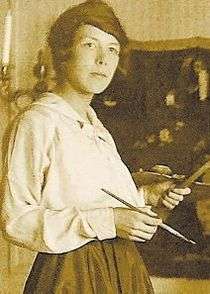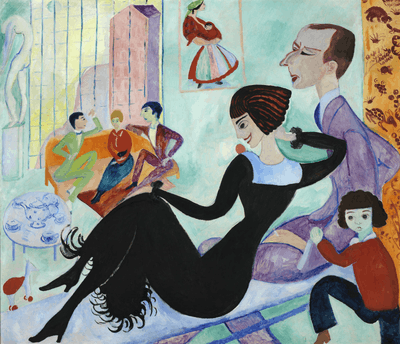Sigrid Hjertén
| Sigrid Hjertén | |
|---|---|
 Sigrid Hjertén at work | |
| Born |
27 October 1885 Sundsvall, Sweden |
| Died |
24 March 1948 (aged 62) Stockholm, Sweden |
| Nationality | Swedish |
| Known for | Painting |
| Movement | Modernism |
Sigrid Hjertén (27 October 1885–24 March 1948), was a Swedish modernist painter. Hjertén is considered a major figure in Swedish modernism. Periodically she was highly productive and participated in 106 exhibitions. She worked as an artist for 30 years before dying of complications from a botched lobotomy for schizophrenia.
Biography
Sigrid Hjertén was born in Sundsvall in 1885. She studied at the University College of Arts, Crafts and Design in Stockholm and graduated as a drawing teacher. At a studio party in 1909, Hjertén met her future husband, twenty-year-old Isaac Grünewald, who had already studied one year with Henri Matisse in Paris. Grünewald convinced her that she would do herself more justice as a painter. Later that year she went to Matisse's art school as well.
1910s
As she studied under Henri Matisse in Paris, she was impressed by the way he and Paul Cézanne dealt with colour. This shows in her painting in contrasting colour fields and simplified contours, her way of achieving the greatest possible expressiveness. Her aesthetic intentions had primarily to do with colour, and in her later works from the 1930s she spoke of colours in terms such as cold yellow. Hjertén strove to find forms and colours that could convey her emotions. In that respect her work is more closely related to the German Expressionists, such as Ernst Ludwig Kirchner, than to the French painters, with their graceful play of lines.
After a year and a half she returned to Sweden. In 1912 Sigrid Hjertén participated in a group show in Stockholm. It was her debut exhibition as a painter. In the following ten years she took part in many exhibitions both in Sweden and abroad, among other places in Berlin in 1915, where she was well received. Sigrid Hjertén was also represented at the Expressionist Exhibition at the Liljevalch's konsthall in Stockholm in 1918, together with two other artists. However, the contemporary critics were not enthusiastic about her art.
In Hjertén's art, where she greatly exposes herself, one notices different stages of development. The influence of Matisse is perhaps mostly discernible in the 1910s. During this decade, Hjertén created many paintings with indoor pictures and views from her home, first at Kornhamnstorg Square and later at Katarinavägen Street, in Stockholm. Her husband Isaac Grünewald and her son Ivàn, as well as Sigrid herself, are often depicted in scenes that embrace various sorts of conflicts. At this time Sigrid Hjertén got acquainted with and inspired by the art made by Ernst Josephson during his illness.
Ateljéinterior

Ateljéinteriör (Studio interior) from 1916 shows how radical Hjertén was for her time. The painting describes the roles she played as artist, woman, and mother: different identities in different worlds. Hjertén sits on the sofa between two artists – her husband, Isaac Grünewald, and, perhaps, Einar Jolin – who talk to each other over her head. Her large blue eyes stare into the distance. In the foreground a woman dressed in black – a sophisticated alter ego – leans against a male figure who might be the artist Nils von Dardel. Her son Ivàn crawls out of the right-hand corner. In the background we glimpse one of Hjertén's paintings of the period, Zigenarkvinna (Gypsy woman). Studio Interior and Den röda rullgardinen (The red blind), from 1916, are daring paintings that have given rise in recent years to new interpretations based on contemporary gender studies and reveal information about the artist's private life.
1920s
Between 1920 and 1932, Sigrid Hjertén and her family lived in Paris, and made many excursions to the French countryside and the Italian Riviera for painting. This was a relatively harmonious era in Hjertén's art, but her exhibits were very limited in this period. Her husband often visited Stockholm where he had a brilliant career. In the late 1920s Hjertén increasingly suffered from various psychosomatic ailments, and she complained of loneliness.
As time passed, an increasing tension can be seen in her art that successively rises and reaches its height immediately before the disease forces Sigrid Hjertén to cease as an artist. In the late 1920s, while she was very isolated in France, colder and darker colours began to appear in her paintings. Recurring diagonal strokes helped to give the paintings a tense impression. During the 1930s Hjertén painted innovative paintings which are characterized by menacing tones, growing storm clouds, and feelings of abandonment.
1930s
In 1932, Sigrid Hjertén decided to return to Stockholm. But during packing she collapsed. She got to Sweden and was temporarily taken to the psychiatric hospital of Beckomberga with symptoms of schizophrenia. She recovered periodically, and in the following two years (1932–34) Hjertén's artistry culminated in a crescendo, where, like one possessed, she made pictures that expressed strongly loaded feelings. She devoted herself to intensive painting, creating one picture a day, the picture-book of her life, according to an interview in the Swedish art magazine Paletten. Some paintings radiate horror while others give a warm and harmonious impression.
During 1934, she traveled with her family in the south of Europe, where she painted. Hjertén eventually made her name as an artist among the critics in 1935, when she exhibited with Isaac in Gothenburg. Yet, most contemporary critics had a negative and even scornful attitude towards Hjertén's works of art, and many of them wrote deeply offensive reviews. Among other things, her paintings were called idiocy, humbug, horrors and products of handicap. She won public recognition only in 1936, when she had a well-received solo exhibition at the Royal Swedish Academy of Arts in Stockholm. Isaac, who had many mistresses over the years, divorced Sigrid and remarried. (Both Isaac and his new wife later died in a flying accident in 1946).
At that time, Sigrid suffered from escalating mental illness, diagnosed with schizophrenia, and was permanently hospitalised at Beckomberga Psychiatric Hospital in Stockholm, where she remained for the rest of her life. After 1938 her artistic output dwindled. Following a botched lobotomy, she died in Stockholm in 1948.
Legacy
Sigrid Hjerén's total production amounted to slightly more than 500 paintings, together with sketches, water-colours and drawings. Hjertén had to fight the prejudices of her time throughout her career. Her paintings seem extremely personal for the era in which they were made, when issues of colour and form were uppermost in artists' minds. Her interest in humankind was often manifested in dramatic, even theatrical compositions, while her approach to colour was emotional as well as theoretical.
References
- (in Swedish) Sigrid Hjertén, by Annika Gunnarsson, in Moderna museet - boken, ed. Cecilia Widenheim et al., Stockholm: Moderna museet, 2004 ISBN 91-7100-724-5
- (in French) Katarina Borgh Bertorp, Sigrid Hjertén: l'hértière de Matisse du Grand Nord: heir of Matisse from the Far North, Paris: Centre Culturel Suédois, 1997
- (in Swedish) Anita Goldman, I själen alltid ren: Om Sigrid Hjertén, Stockholm: Natur & Kultur, 1995, ISBN 91-27-05485-3